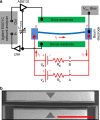Microelectromechanical reprogrammable logic device
- PMID: 27021295
- PMCID: PMC4820632
- DOI: 10.1038/ncomms11137
Microelectromechanical reprogrammable logic device
Abstract
In modern computing, the Boolean logic operations are set by interconnect schemes between the transistors. As the miniaturization in the component level to enhance the computational power is rapidly approaching physical limits, alternative computing methods are vigorously pursued. One of the desired aspects in the future computing approaches is the provision for hardware reconfigurability at run time to allow enhanced functionality. Here we demonstrate a reprogrammable logic device based on the electrothermal frequency modulation scheme of a single microelectromechanical resonator, capable of performing all the fundamental 2-bit logic functions as well as n-bit logic operations. Logic functions are performed by actively tuning the linear resonance frequency of the resonator operated at room temperature and under modest vacuum conditions, reprogrammable by the a.c.-driving frequency. The device is fabricated using complementary metal oxide semiconductor compatible mass fabrication process, suitable for on-chip integration, and promises an alternative electromechanical computing scheme.
Figures









References
-
- Babbage H. P. Babbage's Calculating Engines Vol. 2, The MIT Press (1984).
-
- Davis M. The Universal Computer Norton (2000).
-
- Theis T. N. & Horn P. M. Basic research in the information technology industry. Phys. Today 56, 44–49 (2003).
-
- Swade D. D. Redeeming Charles Babbage's mechanical computer. Sci. Am. 268, 86–91 (1993). - PubMed
-
- Halg B. On a micro-electro-mechanical nonvolatile memory cell. IEEE Trans. Electron Devices 37, 2230–2236 (1990).
Publication types
LinkOut - more resources
Full Text Sources
Other Literature Sources
Research Materials

